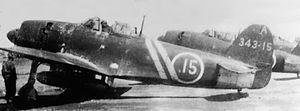Type Naval aviation unit | Allegiance Empire of Japan Size various | |
 | ||
Active January 1, 1944–July 10, 1944December 25, 1944–postwar Role Fighter, interceptor fighter Similar Imperial Japanese Navy, Jagdverband 44, Imperial Japanese Army, Jagdgeschwader 300, Special Naval Landing | ||
343rd naval air group at bombing of kure
The 343rd Naval Air Group (第三四三海軍航空隊, Dai San-Yon-San Kaigun Kōkūtai) was an aircraft and airbase garrison unit of the Imperial Japanese Navy (IJN) during the Pacific campaign of World War II. Created in 1944 due to the desperate situation of Japan in the closing stages of the war, the 343rd was composed of the best surviving ace fighter pilots the Imperial Navy had at the time, with Captain Minoru Genda in command. This unit was equipped with the best airplane Japan had, the Kawanishi N1K2-J Shiden Kai, nicknamed George by the Allies, this aircraft could compete with Allied planes at the time, the F6F Hellcat, the P-51 Mustang and the F4U Corsair. This unit achieved success however it was far too late to have any affect in the war.
Contents
Operational history
IJN 343rd Air Group (343 Kōkūtai Naval Fighter Group), commanded by Minoru Genda, which was constituted on 25 December 1944. The new 343rd Kōkūtai consisted of the best pilots, including Kaneyoshi Muto. The unit was issued the best equipment available and was also equipped with the new Nakajima C6N Saiun, codenamed "Myrt" long-range reconnaissance aircraft.
On 18 March 1945, one of the "Myrts"' managed to spot U.S. carriers en route to Japan. The following morning, 343 Kōkūtai's Shidens intercepted 300 American aircraft. Many of the 343 Kōkūtai Shiden force were N1K2s. When the Shidens encountered VBF-17 Hellcats, three aircraft were lost on both sides in the initial attack; one Hellcat and two Shiden were shot down by enemy ground fire, two fighters collided in mid-air, and one Hellcat crashed while trying to land. Then the other Shiden dove on the Hellcats, downing another one. In the end, the 407 Hikōtai lost six fighters versus downing eight VBF-17 Hellcats.
In another encounter with VBF-10 Corsairs, two of the Corsairs were separated from the main formations, and then attacked by 343rd Shidens. Four N1K2s were shot down and the Corsairs managed to return to their carrier, USS Bunker Hill. An opportunity for revenge came when VFM-123 Corsairs were surprised by Shidens, initially mistaken for Hellcats. A 30-minute aerial duel ensued in which three Corsairs were shot down and another five were damaged. Three other F4Us which had landed on carriers were so heavily damaged that they had to be pushed into the sea. Of the 10 Japanese aircraft the Americans claimed, not one was effectively downed. Two Shidens however, were shot down at landing by Hellcats of VF-9. Many other Shidens were destroyed by American fighters over another airfield, where they tried to land because they were low on fuel. At the end of the day, 343° declared 52 victories, U.S. fighters 63. The actual losses were 15 Shidens and 13 pilots, a "Myrt" with its three-man crew, and nine other Japanese fighters. The U.S. also had heavy losses, with 14 fighters and seven pilots, and 11 other attack aircraft.
Five days later, an unofficial award was sent to 343 Kōkūtai for the valour shown on 19 March. On 12 April 1945 another fierce battle involved 343°, during Kikusui N.2. The Japanese scored several victories but suffered 12 losses out of 34 machines. On 4 May, another 24 Shidens were sent in Kikusui N.5.
The 343 Kōkūtai, remained operational until the overwhelming unit losses led to its eventual retirement. According to one source, 91 pilots from the 343 Kokutai died in battle. The 343rd was disbanded on 14 August 1945, when the Emperor ordered surrender.
Structure
Second generation
Reborn as interceptor fighter unit.
